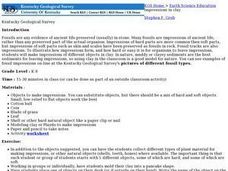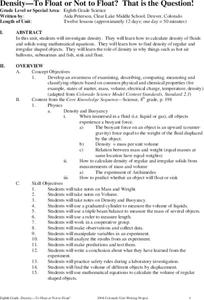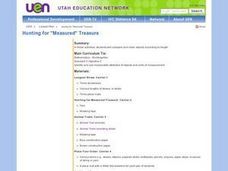Curated OER
Is Your Blue Really Blue? [Metamerism]
Students learn fundamentals about color perception, and explain the phenomenon called "metamerism". Students learn the three basic components of color perception: light source, illuminated colored object, and the light detector.
Curated OER
X Marks the Spot
Fourth graders use games and puzzles to explore co-ordinate systems and their uses. Students are given the opportunity to invent their own systems by locating counters on a sheet of paper and by finding the dead center of a set of objects.
Curated OER
Do you see what I see?
Students examine the importance of making and recording observations and accurately describing an object. In this biology lesson students work in groups and report to the class what they learned.
Curated OER
Density Lab
For this biology worksheet, students use the website given to become familiar with the equipment of a lab. The activity involves a link to a virtual laboratory. Then they determine an objects mass and volume by placing it in a graduate...
Curated OER
Remembrance of Yours--Analyzing Characters Using Mementos
Students choose two characters in Hamlet and symbolize the characters with an object, or find an object that the characters might carry. In this Hamlet lesson, students find an object to represent each character they choose. The object...
Curated OER
Bits and Pieces
In this activity, students will use a collection of objects as the basis for writing a tale about the people who used them.
Curated OER
Teaching Matter with The Wild Christmas Reindeer
Second graders learn the proper way to take measurements, explore the properties of objects and expand their vocabulary.
Curated OER
Seesaws
Students make direct comparisons between objects using balance and spring scales. They also are encouraged to estimate which object is heavier by holding the objects before using the balance scales. Comparing the masses of objects is the...
Curated OER
Preposition Practice
Learners learn about prepositions. In this grammar lesson, students define prepositions and learn how they work. Learners study a list of common prepositions and locate them in sentences.
Curated OER
Impressions in Clay
Students examine how fossils are created. They make impressions of different objects in clay and compare them to examples of fossils.
Curated OER
Simple Machines/Technology/ Force
Third graders study and define force. They determine that the cause of movement is pushing or pulling which are the types of force used when operating simple machines. They experiment to determine which object requires the most amount of...
Curated OER
Ice Ain't Easy
Students are introduced to the laws of thermodynamics. The 1st law of thermodynamics states that the energy must be conserved when two objects of different temperatures come in contact. If one object gains energy, the other object must...
Curated OER
The Spin Doctor Is In
Students are given the difintion of translational motion, which is the object in motion stays in motion. If you are in a car and the car stops, you keep moving. They then discuss rotational motion, which is a spinning object continues to...
Curated OER
Marine Life: Whales
Sixth graders delve into a study of whales. In this biology lesson plan, 6th graders fill in crossword puzzle utilizing vocabulary generated from the comparing and contrasting of common- and less common-place objects.
Curated OER
Estimating and Measuring Capacity: Millilitres And Litres
In this estimating and measuring worksheet, learners will estimate the capacity of 10 objects and record information in liters and milliliters. Then students will measure the actual capacity of these objects and record to complete a table.
Curated OER
Density - To Float or Not to Float? That is the Question!
Students investigate how to find the density of fluids and solids using math. Students also learn how to find the density of regular and irregular shaped objects.
Curated OER
Hanging Around
Students explore weight by building a spring scale and observing how it responds to objects with different masses. Each team of students can make their own spring scale by following steps which are specifically outlined in the plan. As...
Curated OER
Hunting for Measured Treasure
Students compare and contrast objects according to their length. In groups, they travel to different centers in their classroom to participate in different sorting activities. They are introduced to how to use a ruler and reading the...
Curated OER
Practice with Mass
Fourth graders investigate the weight/mass of a number of items using grams, and equivalents. They examine the use of a triple beam balance before massing objects including oil and water. They go over the weights they amassed and weigh...
Curated OER
Inventors and Inventions 1
Pupils research how Velcro and sticky notes were invented. In this research report, students use the Internet to learn about how to common inventions came to be. Pupils write a report about their findings.
Curated OER
Learning to Use Prepositional Phrases
In this prepositional phrases worksheet, students answer or fill in the blanks to 5 facts about prepositional phrases. Students underline the preposition in 9 sentences and then write the object of the preposition on the lines provided.
Curated OER
Music to Your Ears
Students explore how the sounds made by everyday objects can be transformed into musical experiences, composing and performing musical pieces using non-traditional instruments.
Curated OER
Water Displacement to Determine Volume
Sixth graders explore the water displacement method to determine the volume of solid objects such as rocks, nails, and marbles.
Curated OER
Classification And Identification
Students explore diagrammatic and taxonomic keys and their application in the marine sciences. They sort and classify objects and organisms based on visual attributes.
![Is Your Blue Really Blue? [Metamerism] Lesson Plan Is Your Blue Really Blue? [Metamerism] Lesson Plan](http://content.lessonplanet.com/resources/thumbnails/94747/large/bwluav9tywdpy2symde4mtixny0zmdywos1smnd6dxauanbn.jpg?1545052463)






















